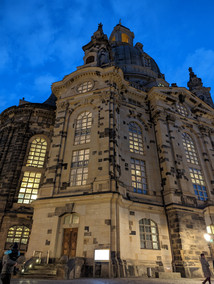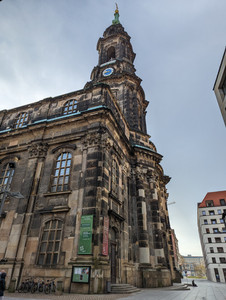I will freely admit that the sum total of my knowledge about Dresden prior to visiting was that it had been utterly obliterated by Allied bombing raids in World War II. This in part fueled my desire to come here in the first place: I felt I had a grossly limited picture in my mind of this city.
In my next sentence, I would have liked to say that my visit blew this narrow view wide open and that the 800-year history and culture of this city revealed itself in a flourish, leaping out from the shadows of those two wicked nights in February 1944.
But I cannot say that, for it would not be quite true.
Instead, I must write that it was as if the very firestorm from the bombing had ripped the oxygen out of this place and limited its ongoing supply so that other things can only be talked about in hushed tones or hurried notes passed back-and-forth in class.

Yes of course, there is more to the history, there's always more: founded in around 1200 AD, Dresden is the capital of Saxony, and the 100-meter-long porcelain Fürstenzug shows the history of the Wettins, who ruled this grand place for 800 years.
And it is not as if the bombing was akin to salt sown in the soil of a sacked Carthage: since the re-unification of Germany at the end of the Cold War, Dresden has advanced and grown, forging a bright future for itself as one of Europe's great urban centres.
It feels top-heavy though, with the see-saw of the last thousand years weighed far down our end today, and the fulcrum in 1944.
For the bombing is in everything, it is everywhere, still. Thanks to 3-D modelling, significant monuments have been resurrected as they once stood 80 years ago using much of the original stone. The old pieces are black where the high iron content in the local sandstone has been exposed to the air forming iron oxide, whilst the newer-cut stone remains white. It will grow dark over time, but for now this gives the buildings a curious checker-board effect.
Beyond the physical level, the bombings have permeated deep into everyday culture. The anniversary is commemorated on February 13 every year, with the accompanying narrative evolving significantly over time.
Initially the bombing was propagandised by the Nazis against the Allies, with the death toll (approx. 25,000) wildly exaggerated to 250,000. Then during the Cold War, it was used by the USSR to sell a narrative of US and Western aggression. In the 1980s, the event was reclaimed by local youth as part of a wider global peace movement. Add in the Holocaust denier David Irving, ongoing debate about the morality of civilian bombing in warfare, and neo-Nazi protesters, and you have a toxic cocktail of actors in a twisted play of ideologies, memory, history, and the truth. The Museum of Dresden puts a brave face on it:
"Today, the culture of commemoration in Dresden is a combination of numerous initiatives and events that respect the suffering and the mourning of those affected at the time, broaden the knowledge of historical research, are committed against the misappropriation of remembering the victims' fate to relativize German crimes, and seek to link this commemoration with a commitment to freedom and understanding."
I am roundly impressed at their intent, regardless of the actual mixed results. To manage an event with such a strong history of its own weaponisation and evolution is an unimaginably difficult task.
***
Compared to the self-aggrandizement of Budapest, with pop-star lights turned on its most magnificent buildings, Dresden feels recalcitrant and shy. At night there is a gloom about the place, as if the air raid blackouts are still being observed all these years later. The moon did its best to coax some showmanship out of the Sächsische Staatskanzlei on the Elbe's eastern bank, but the scene remained stately and solemn.
























Comments